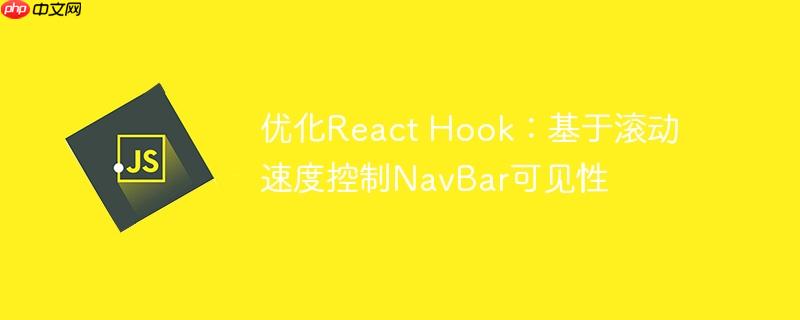
本文旨在优化一个用于控制NavBar可见性的React Hook,该Hook根据页面滚动位置、滚动方向和滚动速度来动态显示或隐藏NavBar。通过引入useCallback来避免不必要的函数重新创建,并详细分析了依赖项,提升了Hook的性能和可维护性,从而实现更流畅的用户体验。
React Hooks 为我们提供了在函数组件中使用 state 和其他 React 特性的强大能力。然而,不当的使用可能会导致性能问题。本文将深入探讨如何优化一个用于控制NavBar可见性的React Hook,该Hook根据页面滚动位置、滚动方向和滚动速度来动态显示或隐藏NavBar。我们将重点关注如何避免不必要的重新渲染和优化事件监听器。
在原始的 Hook 实现中,handleScroll 函数在每次渲染时都会被重新创建。这会导致每次滚动事件触发时,都需要进行不必要的函数比较和重新绑定,从而影响性能。为了解决这个问题,我们可以使用 useCallback Hook 来缓存 handleScroll 函数。
const useScrollSpeed = (navHeight: number, maxScrollSpeed: number) => {
const [lastScrollTime, setLastScrollTime] = useState(new Date().getTime());
const [currentScrollPos, setCurrentScrollPos] = useState(0)
const [prevScrollPos, setPrevScrollPos] = useState(0);
const [visible, setVisible] = useState(true);
const handleScroll = useCallback(() => {
const distance = Math.abs(currentScrollPos - prevScrollPos);
const scrollSpeed = distance / (new Date().getTime() - lastScrollTime);
if (currentScrollPos > prevScrollPos) {
setVisible(false);
} else {
if (scrollSpeed > maxScrollSpeed) {
setVisible(true);
}
}
setPrevScrollPos(currentScrollPos);
setLastScrollTime(new Date().getTime());
}, [currentScrollPos, prevScrollPos, lastScrollTime, setVisible, maxScrollSpeed]);
useEffect(() => {
setCurrentScrollPos(window.scrollY)
if (currentScrollPos < navHeight) {
setVisible(true);
}
window.addEventListener("scroll", handleScroll);
return () => window.removeEventListener("scroll", handleScroll);
}, [currentScrollPos, handleScroll, navHeight]);
return visible;
};
export default useScrollSpeed;useCallback 接收两个参数:要缓存的函数和一个依赖项数组。只有当依赖项数组中的值发生变化时,useCallback 才会返回一个新的函数实例。 在本例中,handleScroll 依赖于 currentScrollPos、prevScrollPos、lastScrollTime、setVisible 和 maxScrollSpeed。确保将所有必要的依赖项都包含在数组中,否则 handleScroll 函数可能不会在状态更新后正确执行。
在 useEffect Hook 中,window.scrollY 被用作依赖项。然而,直接使用 window.scrollY 作为依赖项会导致每次滚动时都触发 useEffect,这可能会导致性能问题。
为了避免这种情况,我们可以将 setCurrentScrollPos(window.scrollY) 移动到 handleScroll 函数中,并移除 useEffect 中对 currentScrollPos 的依赖。
const useScrollSpeed = (navHeight: number, maxScrollSpeed: number) => {
const [lastScrollTime, setLastScrollTime] = useState(new Date().getTime());
const [prevScrollPos, setPrevScrollPos] = useState(0);
const [visible, setVisible] = useState(true);
const handleScroll = useCallback(() => {
const currentScrollPos = window.scrollY;
const distance = Math.abs(currentScrollPos - prevScrollPos);
const scrollSpeed = distance / (new Date().getTime() - lastScrollTime);
if (currentScrollPos > prevScrollPos) {
setVisible(false);
} else {
if (scrollSpeed > maxScrollSpeed) {
setVisible(true);
}
}
setPrevScrollPos(currentScrollPos);
setLastScrollTime(new Date().getTime());
}, [prevScrollPos, lastScrollTime, setVisible, maxScrollSpeed]);
useEffect(() => {
if (window.scrollY < navHeight) {
setVisible(true);
}
window.addEventListener("scroll", handleScroll);
return () => window.removeEventListener("scroll", handleScroll);
}, [handleScroll, navHeight]);
return visible;
};
export default useScrollSpeed;现在,useEffect 仅在 handleScroll 和 navHeight 发生变化时才会触发,从而显著减少了不必要的渲染。 此外,初始的可见性判断也被移到了 useEffect 中,确保在组件挂载后立即执行。
通过使用 useCallback 缓存事件处理函数和优化 useEffect 的依赖项,我们可以显著提高 React Hook 的性能。 关键在于理解 Hooks 的工作原理,并仔细分析哪些值应该作为依赖项,以及如何避免不必要的重新渲染。 记住,优化的目标是减少组件的渲染次数,并确保只有在必要时才执行昂贵的操作。 通过这些优化,我们可以创建一个更流畅、更高效的用户体验。
以上就是优化React Hook:基于滚动速度控制NavBar可见性的详细内容,更多请关注php中文网其它相关文章!

每个人都需要一台速度更快、更稳定的 PC。随着时间的推移,垃圾文件、旧注册表数据和不必要的后台进程会占用资源并降低性能。幸运的是,许多工具可以让 Windows 保持平稳运行。

Copyright 2014-2025 https://www.php.cn/ All Rights Reserved | php.cn | 湘ICP备2023035733号